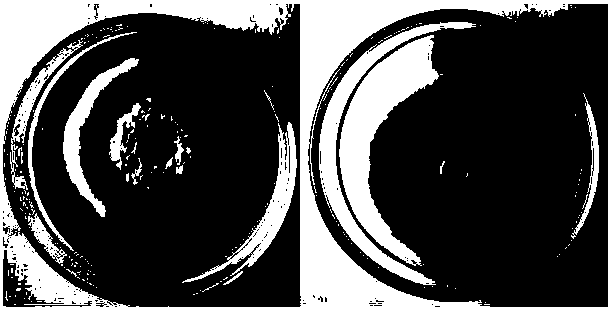Pymetrozine-resistant isaria javanica and application thereof
A technology of I. clavulata and pymetrozine, applied in the field of biological control, to solve the problem of drug resistance and pesticide residue, and reduce the amount of use
- Summary
- Abstract
- Description
- Claims
- Application Information
AI Technical Summary
Problems solved by technology
Method used
Image
Examples
Embodiment 1
[0026] Example 1 Isolation and identification of I. javanica
[0027] 1. Source of materials
[0028] (1) The carcasses of the brown planthopper [Nilaparvata lugens (Stal)] infected by the fungus were collected from the rice in Guangzhou area.
[0029] (2) Czapek medium (Czapek): 30.0g sucrose, ammonium nitrate (NH 4 NO 3 ) 3.0g, potassium dihydrogen phosphate (KH 2 PO 4 ) 1.0g, magnesium sulfate (MgSO 4 .7H 2 O) 0.5g, potassium chloride (KCl) 0.5g, ferrous sulfate (FeSO 4 ) 0.01g, 20g of agar powder into a beaker, add water to heat and dissolve to make the total volume 1000ml, and then sterilize by autoclave (121°C, 20min).
[0030] (3) Aseptic operation conditions: All utensils and utensils must be sterilized by autoclaving (121°C, 30min), and operations such as inoculation are carried out in an ultra-clean workbench.
[0031] (4) Culture conditions: culture in an incubator at 25±1°C under light (14L:10D). After the colonies are formed, transfer them to the slant of ...
Embodiment 2
[0043] Example 2 Screening of excellent strains of I. javanica
[0044] I. javanica is diverse in terms of genetics, ecology, and biology. Different strains of the same fungus have significant differences in pathogenicity to target pests. Different strains have different LD 50 , LT 50 The difference can be several times to tens of times. The screening and acquisition of high-yielding and high-quality strains is the first prerequisite for achieving better control effects when controlling pests. Based on the three commonly used indicators of pathogenicity, spore production, and spore germination rate, the excellent strains of I. javanica were screened.
[0045] 1. Treatment of test strains
[0046] The 8 isolates of I. javanica A, B, C, D, E, F, G, and H obtained after purification were inoculated on the Chase medium plate, and placed in an incubator at 25±1°C (14L: 10D ) cultured.
[0047] 2. Tested insects and host plants
[0048] For brown planthoppers, inoculate the bro...
Embodiment 3
[0070] Example 3 Determination of pathogenicity of I. javanica strain IJNL-N8 to brown planthopper
[0071] 1. Bioassay is one of the effective means to detect the lethality and lethality rate of entomogenic fungi to target pests, and it can provide an important reference for comprehensive evaluation of the biological control potential of fungi. In this study, the pathogenicity of I. javanica IJNL-N8 strain to brown planthopper was carried out to screen out the optimal concentration for control.
[0072] (1) Tested insects and host plants: brown planthopper, inoculate the adult brown planthopper raised on rice in the net room to insect-free rice plants, and place them in insect cages (60×60×60cm) at 25±1°C , to be used when the brown planthopper on the rice plant develops to the 3rd, 4th, and 5th instar nymphs. The rice is a conventional cultivar, provided by Mr. Liu Yongzhu of South China Agricultural University, and the potted seedlings higher than 30 cm after tillering wer...
PUM
 Login to View More
Login to View More Abstract
Description
Claims
Application Information
 Login to View More
Login to View More - R&D
- Intellectual Property
- Life Sciences
- Materials
- Tech Scout
- Unparalleled Data Quality
- Higher Quality Content
- 60% Fewer Hallucinations
Browse by: Latest US Patents, China's latest patents, Technical Efficacy Thesaurus, Application Domain, Technology Topic, Popular Technical Reports.
© 2025 PatSnap. All rights reserved.Legal|Privacy policy|Modern Slavery Act Transparency Statement|Sitemap|About US| Contact US: help@patsnap.com



